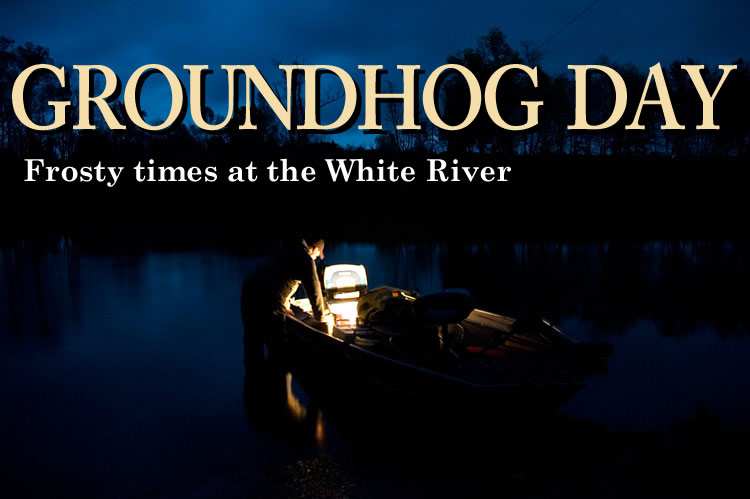Groundhog Day
encased the gunnels of the long white jon boat as we motored into position beneath the looming shadow of Bull Shoals Dam near Mountain Home, Arkansas. It was Groundhog Day. When, bundled like polar explorers, we loaded up in the pre-dawn darkness, the mercury in the thermometer had threatened to disappear. We stashed our waving fly rods and prepared our flesh flies by head lamp.
Of course when the closure period ends, that means the state-park-zone can be a free-for—all—something akin to an annual water rodeo—especially if there is also a shad kill, an event which creates a feeding frenzy for browns. On the other side of the dam, threadfin and gizzard shad are the primary forage base in Bull Shoals Lake. In winter, the shad will cluster in the warmest water they can find, often near the dam. On supremely cold days, usually around the beginning of February, the shad will go into thermal shock when surface temperatures drop low enough that their bodies cannot draw oxygen out of the water. This tends to be a lake temperature of about forty two degrees—not cold enough to freeze the fish, just to shut them down.
Like all hydroelectric dams, Bull Shoals has generating turbines. Very cold days tend to ramp up power demand so that people can heat their homes; thus the White River System dams often generate at full capacity. On Bull Shoals, with its eight power units, that capacity is up to a very burly 26,000 cubic feet per second—enough that you need to motor pretty hard just to maintain position in the current.
When you send a cluster of thermo-shocked fish through a set of turbines operating like a garbage disposal in a loaded sink, the effects are predictable: chopped up shad (and not a few whole ones) get flushed through the dam, creating a bonanza in the tailwater below.
That is the allure of subzero fishing on the White River in February. Everything about the conditions tells you to stay home: It is freezing, it is dark, the river is dangerous, the tackle required is heavy, and there may be other anglers trying to do the same thing you are. But fisherman are eternal optimists, and they will accept any condition up to and including “life-threatening” for the chance at the huge, hungry browns in the waters below. And the fish are huge. The White River has produced world-record brown trout several times, and many anglers believe there are more fish of that class waiting to be caught.
 Trying a few casts from the shoreline
Trying a few casts from the shorelineYou do need the timing to be right. As my friend and I approached the dam, I could see that things were not likely to pan out. Air temperatures were predicted to be above forty by noon and the dam was scheduled to power down. Moreover, the shad kill had started a few days prior when the waters were still closed; and thus the trout were likely to be at the bottom of the river, gorged out like leopards in the week after a big kill.
We unstrung our 8-weight fly rods anyway and began making long casts into the drink. Near the end of our last pass, the water beneath my friend’s fly bulged. Six hours of mindless casting suddenly telescoped into one moment, when the huge old brown turned down and my friend’s rod doubled over—and over, and then still further. I looked at his face, seeing the panic in his eyes, and understood. His reel had gotten wet and the line had frozen together, meaning it could not unwind. Eight pounds of live trout? Maybe 10? However much he weighed, it was enough to quickly overwhelm my friend’s tippet, and with a heart-sickening “snick” the rod released, bounced straight. We drifted on, adrenaline still surging.
Fortunately, just like in the Bill Murray movie, Groundhog Day repeats itself. The shad kill will be there next year, and the year after that, and we will be back.
With a portable heater.
This article originally ran in the February 2013 issue of Arkansas Life magazine.
Contact Information
Shad Kill trips on the fly can be booked out of Dally’s Ozark Fly Fisher (870-435-6166; theozarkflyfisher.com) in Cotter, Blue Ribbon Fly Shop (870-425-0447; blueribbonflyfish.com) in Mountain Home, or Fulton’s Lodge (870-430-5338; mtnhome.net/fultons) in Cotter.
Local guides Jimmy Traylor (870-445-3848; flyfisharkansas.com), Davy Wotton (870-404-5223; davywotton.com), and Chad Johnson (870-435-6166; theozarkflyfisher.com) specialize in the technique—and know how to do it safely.








Leave a Reply